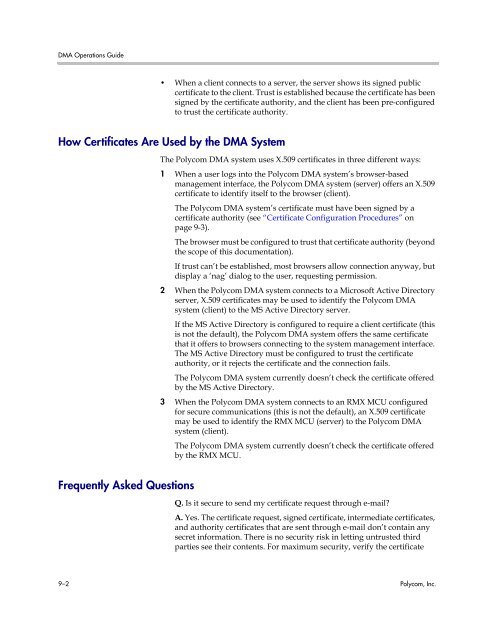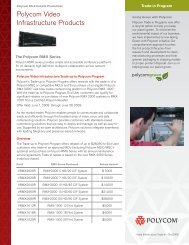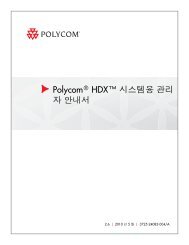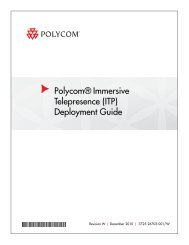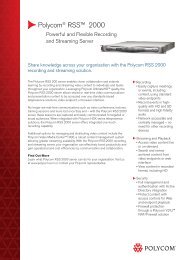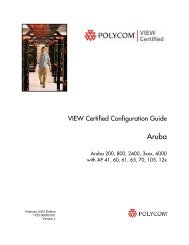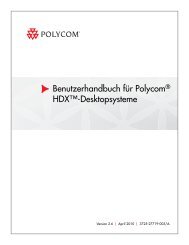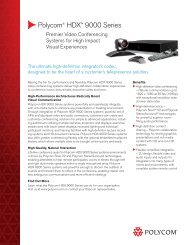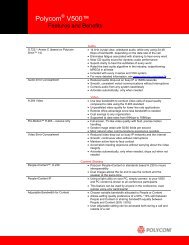Polycom DMA 7000 System Operations Guide
Polycom DMA 7000 System Operations Guide
Polycom DMA 7000 System Operations Guide
You also want an ePaper? Increase the reach of your titles
YUMPU automatically turns print PDFs into web optimized ePapers that Google loves.
<strong>DMA</strong> <strong>Operations</strong> <strong>Guide</strong><br />
• When a client connects to a server, the server shows its signed public<br />
certificate to the client. Trust is established because the certificate has been<br />
signed by the certificate authority, and the client has been pre-configured<br />
to trust the certificate authority.<br />
How Certificates Are Used by the <strong>DMA</strong> <strong>System</strong><br />
Frequently Asked Questions<br />
The <strong>Polycom</strong> <strong>DMA</strong> system uses X.509 certificates in three different ways:<br />
1 When a user logs into the <strong>Polycom</strong> <strong>DMA</strong> system’s browser-based<br />
management interface, the <strong>Polycom</strong> <strong>DMA</strong> system (server) offers an X.509<br />
certificate to identify itself to the browser (client).<br />
The <strong>Polycom</strong> <strong>DMA</strong> system’s certificate must have been signed by a<br />
certificate authority (see “Certificate Configuration Procedures” on<br />
page 9-3).<br />
The browser must be configured to trust that certificate authority (beyond<br />
the scope of this documentation).<br />
If trust can’t be established, most browsers allow connection anyway, but<br />
display a ‘nag’ dialog to the user, requesting permission.<br />
2 When the <strong>Polycom</strong> <strong>DMA</strong> system connects to a Microsoft Active Directory<br />
server, X.509 certificates may be used to identify the <strong>Polycom</strong> <strong>DMA</strong><br />
system (client) to the MS Active Directory server.<br />
If the MS Active Directory is configured to require a client certificate (this<br />
is not the default), the <strong>Polycom</strong> <strong>DMA</strong> system offers the same certificate<br />
that it offers to browsers connecting to the system management interface.<br />
The MS Active Directory must be configured to trust the certificate<br />
authority, or it rejects the certificate and the connection fails.<br />
The <strong>Polycom</strong> <strong>DMA</strong> system currently doesn’t check the certificate offered<br />
by the MS Active Directory.<br />
3 When the <strong>Polycom</strong> <strong>DMA</strong> system connects to an RMX MCU configured<br />
for secure communications (this is not the default), an X.509 certificate<br />
may be used to identify the RMX MCU (server) to the <strong>Polycom</strong> <strong>DMA</strong><br />
system (client).<br />
The <strong>Polycom</strong> <strong>DMA</strong> system currently doesn’t check the certificate offered<br />
by the RMX MCU.<br />
Q. Is it secure to send my certificate request through e-mail?<br />
A. Yes. The certificate request, signed certificate, intermediate certificates,<br />
and authority certificates that are sent through e-mail don’t contain any<br />
secret information. There is no security risk in letting untrusted third<br />
parties see their contents. For maximum security, verify the certificate<br />
9–2 <strong>Polycom</strong>, Inc.


